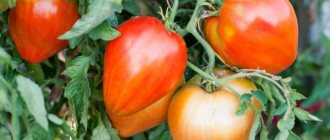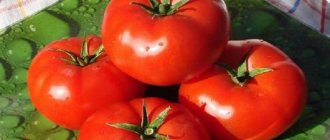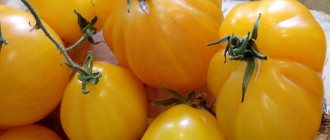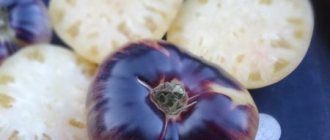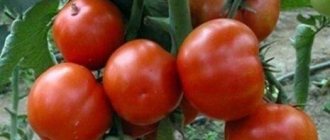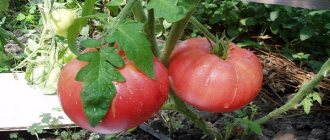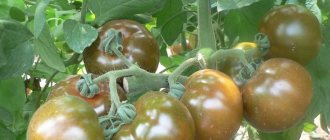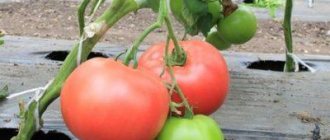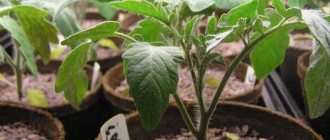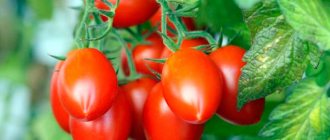Characteristics and description of the variety
The Peter the Great tomato belongs to the cluster hybrids and is intended for cultivation mainly in closed ground. Planting in open ground is possible only in mild climates, with a small difference between day and night temperatures.
The plant is indeterminate, has a powerful stem and great growth vigor. Without pinching the top, the height of the bush can exceed 2 m, and the number of carpal ovaries on it reaches 45 pieces.
Advantages of the Peter the Great variety:
- quick response to agrotechnical manipulations - fertilization, pruning;
- productivity - if you follow the care recommendations, the yield reaches 10 kg per square meter. m;
- universal use of fruits with excellent taste characteristics;
- long shelf life of fruits, low losses during harvest transportation.
The fruits of the hybrid Peter the Great are distinguished by an elongated pepper-shaped shape with a small spout. The average size is 10-12 cm, the average weight is 120 g. The skin and pulp of a ripe tomato are bright red in color, without light areas or spots. The structure of the pulp is dense, not watery, with a high percentage of dry matter. The taste is rich, sweetish.
Tomato Peter the Great F1
For a hybrid, the taste of “Peter the Great” is 5 points! It slightly lacks the aroma, sourness and juiciness of the “Soviet grandmother’s” varieties, but it is not tasteless and plastic, like tomatoes from imported greenhouses. When I saw it for the first time, I immediately wanted to breed it myself - the variety sank into my soul with its appearance. The fruits are not round or oval, but in the shape of an elongated cylinder with a touching long nose. If they get enough sun in the summer, they turn a deep crimson color and seem to glow from within. Due to the fact that the skin is quite dense, they have good shelf life and resistance to transportation - several times I had to transport baskets of tomatoes in the heat of 300 km, not a single one burst or leaked. The only inconvenience is that standard buckets are unsuitable for transportation precisely because of the unusual shape of the tomatoes; I had to buy long flat baskets. In preservation, the factor of dense pulp and hard thick skin is indispensable. Even if salt is placed tightly in rows in a barrel, the tomatoes do not crack, the inside does not soften to the point of porridge. To get a larger harvest, I grow a bush with 2 trunks, and put the branches on supports so that they do not break.
We have never been able to grow a good harvest of this variety just in the garden; after all, our Leningrad climate is not very suitable for mid-early vegetables. Only 2-3 tomatoes were formed on the brush, and not the 8 promised. At the flowering stage, many flowers simply begin to rot due to cold and humidity. It’s a completely different matter in the greenhouse, here “Peter the Great” unfolded in all its glory - in the first year it produced 5 kg of tomatoes per bush, while it was led into only 1 trunk, so as not to overload the branch with tassels. Next year I will definitely plant it in 2 trunks, as experienced gardeners recommend, to get more fruit. The variety does not require any special care; I do not treat the seeds with growth stimulants before sowing; the seedlings hatch quickly and grow vigorously even without this. For mature bushes, watering and fertilizing are traditional; there is no need to pick off the leaves so that the bush does not thicken - there are only a few of them, and they do not interfere with harvesting at all. Fresh tomatoes can be stored for a very long time, especially in a dark, cool and dry place. We ate the last fruits of last year's harvest on February 23rd, and they did not dry out at all or become tasteless. I didn’t even store it in boxes with sand or sawdust, but simply layered it with old newspapers.
The too hard skin of this variety is not too much of a drawback; there are simply varieties that are more suitable for canning, and others for salads. “Peter the Great” produces delicious adjika and aromatic lecho, as well as canned tomatoes (whole). This variety is intended for cultivation in the southern zone (if you choose open ground), where the climate is colder - in greenhouses. The fruits on the clusters are placed very beautifully: exactly in a row, all in size. The brushes are filled along the entire length. The ovary is formed until frost. I collect a lot of tomatoes - 5 kg from each bush. The last ones, which I remove in the fall, I put in a box in one layer, and they lie like that until spring, without fading or deteriorating.
The variety “Peter the Great” is distinguished by the shape of its fruits - cylindrical, with a spout. The color of the tomatoes is red, the weight reaches from 80 to 120 grams. The bushes grow large and tall, so tying is required. Advantages of the variety: + resistance to wilting; + interesting, non-standard tomato fort; + high taste qualities; + suitable for transportation and storage due to the dense structure of the tomato. I plant seeds for seedlings 60-65 days before planting in the ground. When planting, I adhere to the rule - per 1 sq. meter of no more than 3 plants, so that the plant can grow and develop normally.
How to grow seedlings
The cultivation of hybrid seedlings occurs according to standard rules, taking into account the specific climate. The thoroughness of seed and soil treatment depends on the level of threat of disease and pest infection in a particular planting region.
Seed preparation
Considering that 60-day-old seedlings should be transplanted into the greenhouse, and the best time for planting will be mid-May (for the middle zone), it is better to sow seeds for growing seedlings in the first half of March.
Hybrid seeds are usually already processed by the manufacturer. But some gardeners still disinfect. Harmful microorganisms can live on the surface of seeds and become activated when they enter the soil. The simplest method of disinfection is soaking in hydrogen peroxide (3% solution) for 20 minutes.
Then the seeds are soaked in water at room temperature for 72 hours, wrapped in clean gauze. As a rule, on the third day the sprouts hatch and the seeds are ready for planting.
Container and soil
Seed material is planted in boxes filled with universal store-bought soil for tomatoes. There must be drainage holes at the bottom of the boxes.
You can prepare the soil yourself by mixing peat, sand, and top layer of garden soil in equal parts. It is recommended to additionally treat the soil with a weak solution of potassium permanganate and add a small amount of organic fertilizer.
Sowing
The seeds are deepened into the ground 1-2 cm, watered with warm water and greenhouse conditions are created by covering the container with soil with film. It is important that the soil in the box does not dry out or cool. The optimal way to moisturize during this period is to spray the soil with a spray bottle.
The greenhouse must be well ventilated twice a day. If these conditions are met, seedlings appear within 7-10 days.
Growing and care
After germination, Peter the Great tomato seedlings need to be provided with good lighting, and in the second week, nitrogen fertilizers should be added to stimulate growth.
When 2-3 leaves appear on the plants, they are picked from a common box into separate cups. The volume of the cups must be at least 0.5 liters so that the grown seedlings feel comfortable.
Disease Prevention
Quite often, gardeners are faced with a tomato disease such as gray rot. To avoid this problem, it is recommended to plant the bushes not too densely. Mechanical damage to seedlings is unacceptable. Any infected tomatoes covered with short gray fluff should be promptly removed. Tomatoes can also be affected by black leg. When this disease appears, the root part of the bushes turns black and dries out. Experienced experts cite thickening of the bushes and excessive waterlogging of the soil as the main reasons why tomatoes suffer from blackleg. The following measures are suitable for prevention:
- timely ventilation of the greenhouse;
- moderate watering;
- use of proven planting material;
- sterile soil.
Fusarium can appear at any stage of plant development. With this lesion, the lower part of the leaves turns yellow and withers, and dark outlines of blood vessels can be seen on the cut of the stem. If such a lesion develops, the tomatoes cannot be cured. In order to avoid having to destroy tomato bushes, it is necessary to first dig up and disinfect the soil, use healthy planting material and control the acidity of the soil. Experts say: at a pH level of 6.5-7, the development of harmful fungus slows down significantly.
How to grow tomatoes
Tomatoes require daily attention from gardeners. Following the recommendations for growing Peter the Great hybrid tomatoes will ensure healthy plants and a rich harvest.
Landing
Peter the Great tomatoes are planted in greenhouses in mid-May - early June. By this point, night temperatures in the greenhouse should not fall below 10 °C.
Planting density per 1 sq. m is 3 bushes when subsequently formed into 2 stems or 4 bushes when formed into 1 stem.
The soil in the greenhouse is prepared in the fall, replacing its top layer with soil from carrot beds. Then they add manure and dig up the soil without breaking up the lumps.
Care
10 days after planting tomatoes in permanent soil, it is well loosened and organic fertilizers are applied. Mineral fertilizers are added before flowering and during the period of fruit appearance.
Plants require abundant watering with warm water - drying out of the deep layers of soil is unacceptable. The soil is loosened weekly to ensure adequate oxygen exchange in the tomato root system.
The bushes grow actively throughout the growing season, and to ripen the fruits, it is recommended to remove the stepsons, pinch the growing points and the crown.
Attention ! During the period of fruit ripening, plants will need strong support - wooden or plastic stakes of sufficient thickness.
Features of cultivation and possible difficulties
With responsible care, the Peter the Great tomato feels comfortable in greenhouse conditions and enters the fruiting period 110-120 days after germination. Sometimes, despite observing all agrotechnical nuances, difficulties are observed with fruit ripening. To help the plant, experienced farmers advise removing some of the tomatoes that have acquired an intermediate brown color.
Throughout the warm season, it is necessary to maintain an optimal level of humidity in the greenhouse - this is ensured by regular watering of the soil and natural evaporation of moisture, but on dry summer days you can install small containers of water between the bushes.
Diseases and pests
Hybrid Peter the Great is resistant to viral and fungal infections, but for prevention it is recommended to periodically treat the above-ground part of the plant with Fitosporin.
When pests appear, we recommend spraying the bushes with an insecticidal preparation. Root protection will be ensured by watering with a solution of copper sulfate.
Caring for a tomato variety
Caring for the plant of the described variety includes a number of traditional measures, which include good watering, high-quality fertilizing, timely pinching, weeding and loosening the soil.
Feeding and watering
Since the crop is characterized by high growth intensity, it needs good, abundant watering, the need for which is determined by the drying of the top layer of soil. When carrying out irrigation procedures, you should focus on the abundance of moisture, and not on their frequency.
Frequent, but small waterings contribute to the formation of small root shoots, which are not able to fully nourish the plant and saturate it with the required amount of moisture. Rare but plentiful moisture promotes the development of a strong and powerful root system, which can provide the bushes with the necessary nutrients and moisture. However, when irrigating, water should not be allowed to stagnate in the soil, as this will lead to rotting of the roots. To moisturize, you should use settled, non-cold, soft water.
Important! It is recommended to water in the morning, evening or in cloudy weather.
It is equally important to organize systematic feeding of the crop, for which it is allowed to use organic matter or complex mineral products. Any fertilizers should be applied only to moist soil, which is why experts recommend combining fertilizing with watering.
Fertilizers are applied for the first time 10 days after planting the seedlings. To do this, prepare an infusion of bird droppings or mullein and herbs. The concentrated solution is diluted with water in a ratio of 1:10 and the bushes are watered. One bucket of fertilizer is enough to feed 10–13 bushes. The second portion of fertilizers is applied during the flowering phase of the crop, and the third during the period of fruit formation. In this case, mineral preparations based on potassium and phosphorus are used. At the end of summer, tomato bushes are sprayed with a solution of boric acid, at the rate of 2–3 g per 1 bucket of water.
Stepping and bush formation
The formation of bushes is one of the mandatory procedures when growing the Peter the Great variety. If you ignore this stage, you will not be able to get a decent harvest of high-quality, large fruits.
Plant formation can be done in two ways:
- In one stem . In this case, all side shoots are removed, leaving only one main, strongest stem. The lateral shoots are trimmed every 10 days, after they reach a length of 5–6 cm. At the same time, the first flowering brush is pinched, which makes it possible to reduce the load on the crop and promote better yield.
- In two stems . With this formation scheme, a central stem and the strongest lateral shoot are left, on which there are at least 5 flowering clusters. The remaining stepsons are removed regularly, every 7–10 days.
As practice shows, the variety shows the best yield results when bushes are formed into two stems.
Read more about how to properly plant tomatoes in open ground.
Loosening the soil and weeding
Experienced gardeners recommend loosening the soil 1–2 times a week, which allows you to:
- saturate the soil with nutrients and enrich it with oxygen, thereby activating the growth of the root system;
- create favorable conditions for bush growth;
- destroy some pests and parasitic larvae living on root shoots.
The first loosening with a deepening of 8–10 cm is carried out a few days after planting the seedlings, the second and subsequent ones - as needed, at least once every 7 days.
In addition to loosening, a mandatory procedure when caring for tomatoes is weeding, the presence of which inhibits the development of the bush and negatively affects the yield. Weeding is carried out regularly, at the first appearance of weeds. It is especially important to destroy parasitic plants before they bloom.
To prevent the appearance of weeds and also retain moisture in the soil, experts recommend covering the soil under the bushes with a layer of mulch - straw, sawdust, hay.
Did you know? Tomatoes contain a unique substance - the powerful antioxidant lycopene, which prevents the formation of cancer cells and also slows down the growth and development of existing ones.
Difficulties in growing
Despite the fact that the variety is quite resistant to many viral and fungal diseases, when growing it, novice summer residents may encounter a number of difficulties, which, as a rule, are associated with violation of the basic rules of agricultural technology. Excessive soil moisture, as well as excess fertilizers, can lead to late blight, fusarium, and powdery mildew . To combat these diseases, as well as for prevention, modern fungicidal preparations are used, for example, Fitosporin, or folk remedies - Bordeaux mixture.
Against parasites such as slugs, whiteflies, aphids , insecticidal preparations “Aktofit”, “Profi” or folk remedies - soap or garlic solutions, potassium permanganate, a mixture of pepper and mustard are especially effective.
Simple preventive measures will help prevent the development of diseases and the appearance of pests:
- compliance with crop rotation;
- timely loosening of the soil and destruction of weeds;
- compliance with the rules of watering and fertilizing;
- systematic professional treatment of bushes with biological products.
It is worth noting that the variety is almost never affected by the pathogen Verticillium wilt.
Also find out what you need to do to make tomatoes turn red faster.
The nuances of growing in open ground and in a greenhouse
The Peter the Great tomato, like many mid-season hybrids, is not intended for growing in open ground. In the southern regions, it is possible to plant bushes outside greenhouses, in beds, but in this case, care should be taken to quickly cover the tomatoes with film from rain or hail.
Growing indoors is possible throughout Russia. At the same time, summer residents from regions located above the middle zone often use heated greenhouses. With proper care, tomatoes bear fruit until the end of September.
Regardless of the form of planting, Peter the Great tomatoes require strong support, good lighting (at least 12 hours a day), and regular feeding.
Important ! Plants must be protected from sudden temperature changes.
Planting and care
Tomato Peter 1 seeds
Tomato Peter 1
Seeds should be planted for seedlings about a couple of months before transplanting the seedlings into beds in the garden or in closed ground. But depending on weather conditions, the date of transplanting seedlings may be postponed.
Tomato Peter 1 hl
Caring for this variety of tomatoes after transplanting to a permanent location is no different from caring for other varieties of tomatoes.
Recommended further care measures:
- After planting in a permanent place, it is necessary to timely remove weeds, carry out regular watering, and loosen the soil as necessary. You can make watering easier by mulching the soil, this will retain moisture for a long period;
- There is no need for pinching and tying;
- To increase productivity, the plant must be provided with an additional source of nutrients. For this purpose, the tomato is fed once a week using complex mineral fertilizers. A good effect can be achieved by adding a few pinches of wood ash to the water for irrigation. During the period when the ovaries are formed, a little wood ash is placed under each bush.
For seedlings, you need full-bodied, smooth planting material without an unpleasant odor, possibly with the aroma of tomatoes. Sowing is done 56-60 days before transplanting to a permanent location. There may be deviations here due to climate change. Seeds do not require pre-treatment.
The soil for seedlings is prepared as follows: mix peat (humus) with turf soil, add superphosphate and wood ash.
Picking is not necessary. If this is not done, the seeds are immediately placed in small pots or cassettes of 3-4 pieces. Then weak shoots are removed and 1-2 strong specimens are left. To save space, some gardeners plant two seedlings in each container, but it is better for them to grow individually, without lack of moisture, light and nutrition.
Peter 1 does not need stepsoning or gartering. If there are a large number of ovaries, you should not tear them off.
The bushes need to be weeded and hilled. The beds are mulched with a thick layer of straw. Along with it they put pine needles, sunflower husks, and freshly mown grass. Before the procedure, the soil must be well heated, otherwise the tomatoes will be stunted in growth. Only moistened soil can be mulched.
Plants must be provided with food, moisture, lighting, and protected from aphids and mites.
Pests attack crops when agricultural practices are violated. This applies mainly to greenhouse tomatoes, since there is high humidity in the shelters.
You can fight insects with insecticides, which are sold in stores, or colloidal sulfur. This folk remedy is used to fumigate greenhouses.
Oksana, Saratov
Two years ago we built a greenhouse. Peter the Great's seedlings were the first to plant from tomatoes. She didn’t sit straight, but at a slight angle. I took the description from “Sedek” as a basis. When growing, the bushes were formed into 2 stems, and excess stepsons were removed. The fruits are too dense for salads, so I used everything for preparation. When pickled, pepper tomatoes taste and look good. Today I planted 5 bushes again, but I neglected the bushes - I didn’t break out the stepsons in time. There were enough tomatoes for harvesting, the fruits were set until the end of August.
The soil substrate for sowing is selected in the store or prepared from garden turf. To do this, compost and ash, some sand and peat are added to it. To disinfect the soil, it is spilled with 1% potassium permanganate or Fitosporin.
Seeds are sown throughout March, planting depth is 1-2 cm.
What are the nuances of caring for seedlings:
- maintaining the soil in a moderately moist state;
- application for irrigation of warm water;
- irrigation 2 times with nutrient complex solutions;
- lighting with special phytolamps so that the duration of the day is at least 12-14 hours.
Ultra-early / Low-growing
User rating: 5/5
Early maturing / Low growing
User rating: 5/5
Early maturing / Low growing
Harvesting and application
The first Peter the Great tomatoes ripen at the end of June - July, the harvest ends in September. During this time, farmers manage to collect up to 10 kg of fruits from 1 square meter. m greenhouse.
The variety is good for fresh consumption and for preservation. The taste and density make it possible to prepare sauces, juices, and tomato paste from these tomatoes. When preserving whole fruits, the strong skin does not burst. The Peter the Great variety is perfect for withering.
Hybrid tomatoes tolerate transportation well and are stored for a long time, so surplus crops can always be sold at a profit. After picking, brown or green fruits are sent to ripen using the traditional method: they are laid out in wooden boxes in 2-3 layers, covered with paper.
Tomato hybrids. Tomato F1 Peter the Great. (Tomato hybrid F1 Peter the Great)
Sowing for seedlings: mid-end of March. Seed placement depth: 1 cm. Picking: in the phase of the first true leaf. Planting seedlings in open ground - at the age of 30 - 35 days. Planting pattern - 70 by 40 cm.
Fruiting: starting in mid-July.
The key to choosing this tomato hybrid was its similarity to the Pepper tomato, as well as its stated high taste qualities and the possibility of long-term fresh storage.
About F1 tomato hybrids Peter the Great from the blog:
March 23, 2016
March 31, 2021. No new shoots appeared in the tray with “Pepper and Prides,” but the only tomato that sprouted turned out to be three-leaved, which is called “bestowed with happiness.” But you won’t be satisfied with happiness alone... In the morning I soaked the seeds of the F1 tomato hybrid Peter the Great and almost the entire remaining reserve of seeds of the Pertsevidny variety (from our own preparations - Tomatoes for seeds. We prepare tomato seeds ourselves). In the evening, I sowed the already swollen seeds into a tray - I had to use the soil prepared for picking. It turns out that these tomatoes were sown on an alternative day on the waning Moon in the sign of Capricorn.
PS We have not used growth stimulants during soaking for several years now - they do not affect germination, and the appearance of the first shoots one day earlier is not significant... All sowings were carried out with precise depth.
View other tomato varieties
Comments are published on the forum online and on this page after approval by the moderator.
What is an F1 hybrid? In our case, this is the result of crossing two tomato varieties, the first generation, i.e. Simply put, seeds obtained as a result of pollination of flowers of one tomato variety with pollen from another variety.
Why are F1 hybrids so common? The designation F1 stands for very simply: the offspring of the first generation. This designation has been preserved since the time of Mendel (the discoverer of the laws of genetics), he then introduced it as an abbreviation for the Latin Filiale 1, and for us it will be mnemonically easier to use the word “Formation 1”. But the main point is not in the designation, but in the fact that it is the first hybrid generation that has two remarkable properties: - the first property, according to the law of uniformity of hybrids of the first generation, is that the similarity of all these plants to each other is higher than that of plants of a well-established varieties; - the second property is that first-generation hybrids have increased vitality, they are larger than their parents and grow faster than them, and most importantly, they are more resistant to diseases - this phenomenon is called “heterosis” in genetics.
So, do not try to save the seeds of the hybrids you like; the F2 hybrid generation grown from these seeds will not have either the first or second properties. The only thing you may be able to get from them is to find out which varieties were the parents of the F1 generation hybrids.
Advantages and disadvantages of the variety
Growing Peter the Great tomatoes does not require complex agricultural manipulations, and even inexperienced farmers can count on a good harvest.
The main advantages of the variety:
- long fruiting;
- resistance to infections and fungi;
- pleasant taste and high fruit density.
No obvious disadvantages of hybrids have yet been identified; the list of possible inconveniences includes:
- large size of bushes, tendency to grow quickly;
- the need for solid support, and not just tying;
- difficult cultivation in open ground;
- it is necessary to partially unload the plant by removing unripe fruits.
Some gardeners find fresh Peter the Great tomatoes too tough to cut into a salad. But this minus turns into a plus when canning.
Farmer reviews
The Peter the Great tomato variety was developed relatively recently and has not yet received sufficient distribution, but reviews from farmers who have become acquainted with the hybrid are mostly positive.
Sergey, 48 years old, Novorossiysk: “High yield compensates for some of the inconveniences of growing. I have a large farm, and good keeping quality guarantees profit from harvest sales.”
Anna, 38 years old, Novgorod: “Summer in our region is not hot, so I only plant tomatoes in a greenhouse. Peter the Great has not failed for 3 years, but every year it is necessary to replace the fertile layer of soil in the greenhouse.”
Irina, 42 years old, Saratov: “It’s nice to go into the greenhouse - the tomatoes have grown powerful and healthy. Large bunches of ripe tomatoes look impressive, and their photos are nice to add to the archive of my agricultural achievements.”
